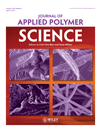Effect of recrystallization on the molecular mobility of a copolymer of vinylidene fluoride and hexafluoropropylene
Abstract
Relaxation processes in copolymers of vinylidene fluoride with hexafluoropropylene (93/7) were studied by means of a dielectric method. The initial extruded film was recrystallized by free heating to temperatures above the melting point and by subsequent cooling. This increased both the perfection of the crystal phase and the degree of crystallinity. The impact of recrystallization on both the relaxation times (τ's) and the activation parameters of the local mobility (β process) and micro-Brownian cooperative mobility in amorphous phase (αa process) was almost negligible, whereas the τ's of the αc relaxation were an order of magnitude higher after recrystallization. Qualitatively, it was predicted by the soliton model for the αc relaxation. The recrystallization affected characteristics of the transition at the highest temperature (α) registered in the region of the melting of the crystals even more. The process is related to the relaxation of the space charge formed by ionogenic impurities, which migrate through the amorphous phase with high free volume. It was shown that the dynamics in the amorphous phase controlled the drift mobility of free charge carriers and, by that, determined the τ of the space charge relaxation process. The structuring processes during the recrystallization also affected the parameters of the order–disorder transition in the low-perfect ferroelectric (antiferroelectric) phase. © 2010 Wiley Periodicals, Inc. J Appl Polym Sci, 2011




